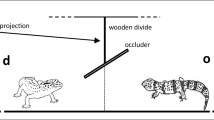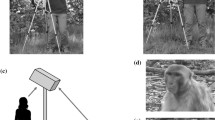Abstract
Although primates have often been found to co-orient visually with other individuals, members of these same species have usually failed to use co-orientation to find hidden food in object-choice experiments. This presents an evolutionary puzzle: what is the function of co-orientation if it is not used for a function as basic as locating resources? Co-orientation responses have not been systematically investigated in object-choice experiments, and requiring co-orientation with humans (as is typical in object-choice tasks) may underestimate other species’ abilities. Using an object-choice task with conspecific models depicted in photographs, we provide experimental evidence that two lemur species (Eulemur fulvus, n = 4, and Eulemur macaco, n = 2) co-orient with conspecifics. Secondly, by analysing together two measures that have traditionally been examined separately, we show that lemurs’ gaze following behaviour and ultimate choice are closely linked. Individuals were more likely to choose correctly after having looked in the same direction as the model, and thus chose objects correctly more often than chance. We propose a candidate system for the evolutionary origins of more complex gaze following: ‘gaze priming.’



Similar content being viewed by others
References
Anderson JR, Mitchell RW (1999) Macaques but not lemurs co-orient visually with humans. Folia Primatol 70:17–22
Barth J, Reaux JE, Povinelli DJ (2005) Chimpanzees’ (Pan troglodytes) use of gaze cues in object-choice tasks: different methods yield different results. Anim Cogn 8:84–92
Brauer J, Call J, Tomasello M (2005) All great ape species follow gaze to distant locations and around barriers. J Comp Psychol 119:145–154
Bruner J (1983) Play, thought, and language. Peabody J Educ 60:60–69
Bugnyar T, Stowe M, Heinrich B (2004) Ravens, Corvus corax, follow gaze direction of humans around obstacles. Proc R Soc Lond B Biol 271:1331–1336
Burkart JM, Heschl A (2007) Understanding visual access in common marmosets, Callithrix jacchus: perspective taking or behaviour reading? Anim Behav 73:457–469
Byrnit JT (2004) Nonenculturated orangutans’ (Pongo pygmaeus) use of experimenter-given manual and facial cues in an object-choice task. J Comp Psychol 118:309–315
Byrnit JT (2008) Gorillas’ (Gorilla gorilla) use of experimenter-given manual and facial cues in an object choice task. Anim Cogn. doi:10.1007/s10071-008-0200-1
Call J, Hare B, Tomasello M (1998) Chimpanzee gaze following in an object-choice task. Anim Cogn 1:89–99
Call J, Agnetta B, Tomasello M (2000) Cues that chimpanzees do and do not use to find hidden objects. Anim Cogn 3:23–34
Csibra G, Gergely G (2006) Social learning and social cognition: the case for pedagogy. Attention Perform XXI:249–274
Dennett DC, Haugeland JC (1987) Intentionality. In: Gregory RL (ed) The Oxford companion to the mind. Oxford University Press, Oxford, pp 383–386
Emery NJ (2000) The eyes have it: the neuroethology, function and evolution of social gaze. Neurosci Biobehav Rev 24:581–604
Ferrari PF, Kohler E, Fogassi L, Gallese V (2000) The ability to follow eye gaze and its emergence during development in macaque monkeys. Proc Natl Acad Sci USA 97:13997–14002
Genty E, Palmier C, Roeder JJ (2004) Learning to suppress responses to the larger of two rewards in two species of lemurs, Eulemur fulvus and E-macaco. Anim Behav 67:925–932
Gómez JC (2008) Pretence in non-human primates: from intentional availability to intentional non-existence. Mind Lang (in press)
Goossens BMA, Dekleva M, Reader SM, Sterck EHM, Bolhuis JJ (2008) Gaze following in monkeys is modulated by observed facial expressions. Anim Behav 75:1673–1681
Hare B, Tomasello M (1999) Domestic dogs (Canis familiaris) use human and conspecific social cues to locate hidden food. J Comp Psychol 113:173–177
Hare B, Tomasello M (2004) Chimpanzees are more skilful in competitive than in cooperative cognitive tasks. Anim Behav 68:571–581
Hauser MD, Glynn D, Wood J (2007) Rhesus monkeys correctly read the goal-relevant gestures of a human agent. Proc R Soc B Biol Sci 274:1913–1918
Horton KE, Caldwell CA (2006) Visual co-orientation and expectations about attentional orientation in pileated gibbons (Hylobates pileatus). Behav Process 72:65–73
Howell, DC (2001) Statistical methods for psychology, 5th edn. Wadsworth Publishing, Belmont
Itakura S (1996) An exploratory study of gaze-monitoring in nonhuman primates. Jpn Psychol Res 38:174–180
Ittyerah M, Gaunet F (2008) The response of guide dogs and pet dogs (Canis familiaris) to cues of human referential communication (pointing and gaze). Anim Cogn. doi:10.1007/s10071-008-0188-6
Kaminski J, Riedel J, Call J, Tomasello M (2005) Domestic goats, Capra hircus, follow gaze direction and use social cues in an object choice task. Anim Behav 69:11–18
Lane DM (2008) Trend analysis. In: HyperStat online statistics textbook. http://davidmlane.com/hyperstat/index.html. Accessed 30 July 2008
Langton SRH, Watt RJ, Bruce V (2000) Do the eyes have it? Cues to the direction of social attention. Trends Cogn Sci 4:50–59
Lorincz EN, Baker CI, Perrett DI (1999) Visual cues for attention following in rhesus monkeys. Cah Psychol Cogn 18:973–1003
Neiworth JJ, Burman MA, Basile BM, Lickteig MT (2002) Use of experimenter-given cues in visual co-orienting and in an object-choice task by a new world monkey species, cotton top tamarins (Saguinus oedipus). J Comp Psycho 116:3–11
Peignot P, Anderson JR (1999) Use of experimenter-given manual and facial cues by gorillas (Gorilla gorilla) in an object-choice task. J Comp Psychol 113:253–260
Povinelli DJ, Eddy TJ (1996) Factors influencing young chimpanzees’ (Pan troglodytes) recognition of attention. J Comp Psychol 110:336–345
Povinelli DJ, Bierschwale DT, Cech CG (1999) Comprehension of seeing as a referential act in young children, but not juvenile chimpanzees. Br J Dev Psychol 17:37–60
Santos LR, Hauser MD (1999) How monkeys see the eyes: cotton-top tamarins’ reaction to changes in visual attention and action. Anim Cogn 2:131–139
Scerif G, Gómez JC, Byrne RW (2004) What do Diana monkeys know about the focus of attention of a conspecific? Anim Behav 68:1239–1247
Shepherd SV, Platt ML (2008) Spontaneous social orienting and gaze following in ringtailed lemurs (Lemur catta). Anim Cogn 11:13–20
Sheskin DJ (2004) Handbook of parametric and nonparametric statistical procedures. CRC Press, Boca Raton
Sokal RR, Rohlf FJ (1995) Biometry: The principles and practice of statistics in biological research, 3rd edn. W.H. Freeman and Company, New York
Tomasello M, Call J, Hare B (1998) Five primate species follow the visual gaze of conspecifics. Anim Behav 55:1063–1069
Tomasello M, Hare B, Agnetta B (1999) Chimpanzees, Pan troglodytes, follow gaze direction geometrically. Anim Behav 58:769–777
Tomasello M, Hare B, Fogleman T (2001) The ontogeny of gaze following in chimpanzees, Pan troglodytes, and rhesus macaques, Macaca mulatta. Anim Behav 61:335–343
Whiten A, Byrne R (1988) The manipulation of attention in primate tactical deception. In: Byrne R, Whiten A (eds) Machiavellian intelligence: social expertise and the evolution of intellect in monkeys, apes, and humans. Oxford University Press, Oxford, pp 211–223
Zuberbühler K (2008) Gaze following. Curr Biol 18:R453–R455
Acknowledgments
Ruiz’s postgraduate study is funded by the Jack Kent Cooke Foundation and the Overseas Research Student Award Scheme provided by the British Council. We are grateful to the staff of the Centre de Primatologie for enthusiasm and support. Many thanks to Klaus Zuberbühler, David Perrett, and Robert S. Kelly for providing feedback and discussion that contributed to this project, to Simon W. Townsend for inter-observer reliability, and to three anonymous reviewers for helpful comments. The authors attest that the above study complies with the current French laws.
Author information
Authors and Affiliations
Corresponding author
Rights and permissions
About this article
Cite this article
Ruiz, A., Gómez, J.C., Roeder, J.J. et al. Gaze following and gaze priming in lemurs. Anim Cogn 12, 427–434 (2009). https://doi.org/10.1007/s10071-008-0202-z
Received:
Revised:
Accepted:
Published:
Issue Date:
DOI: https://doi.org/10.1007/s10071-008-0202-z




